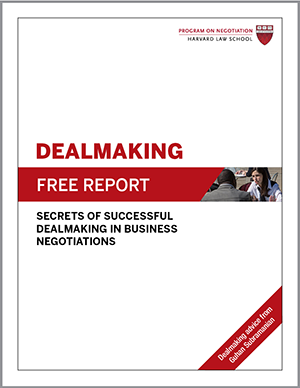
Do let your deal stall – here are some dealmaking tips for a successful negotiation
When talks stall, it’s tempting to jump to conclusions: “It’s purely a price gap.” “They’re being unreasonable.” “We’re not communicating well.” “We’re in a weak position.”
Three dimensions of dealmaking
Instead of focusing on the first explanation that leaps to mind, you should diagnose the key barriers to agreement so that you can devise the most promising approach to overcoming them.
In our book 3-D Negotiation: Powerful Tools to Change the Game in Your Most Important Deals (Harvard Business Review Press, 2006),” David Lax and James Sebenius classify three dimensions of dealmaking: (1) tactics and interpersonal interactions “at the table,” (2) deal design, and (3) deal setup “away from the table.” With a thorough 3-D audit of the barriers that stand between you and your desired deal, you can consciously craft your negotiation behavior to overcome them.
Three critical questions
Before a negotiation and when talk stalls, take time to answer the following three questions, which correspond to our three dimensions:
1. Are the barriers to agreement tactical and/or interpersonal? When you see strong potential for a mutually beneficial deal, yet you can’t seem to get there from here, common interpersonal or tactical barriers may be holding you back. These include poor communication, lack of trust, cross-cultural clashes, and hardball tactics.
2. Do the barriers result from poor deal design? A barrier can arise when one or both sides are dissatisfied with the agreement on the table. A poor deal may fail to maximize the potential “value pie” or fail to accomplish the parties’ objectives, or it can offer insufficient value relative to parties’ aspirations or walkaway options, or both.
3. Do the barriers result from a flawed setup? A flawed setup can indicate problems with the negotiation’s scope, sequence, or process choices. You might be dealing with the wrong parties, interests, issues, or no-deal options; there could be problems with the order in which you approach parties or deal with issues; or parties may have overlooked the potential benefits of joint fact finding or mediation.
First-dimension barriers: Interpersonal and/or tactical
If the other side just doesn’t seem to understand your key interests, priorities, or limits, you may not be presenting your ideas clearly, or she may not be listening well.
Imagine that a supplier is negotiating with an important but difficult client who adamantly refuses to budge on certain contract terms. Assuming that they face an interpersonal barrier, suppliers often seek training on the principles of persuasion, joint brainstorming, initial offers, body language, and so on.
Yet apparent tactical or interpersonal barriers may actually be another type of problem. As the purchasing agent calms down a bit, for example, he mentions that cash is very tight, “especially this quarter.” Is this a deal design barrier? Perhaps a delayed payment schedule would do the trick, with the bulk of the payment due when procurement budgets are replenished.
Second-dimension barriers: Poor deal design
Consider the following real-world dispute. Environmentalists and farmers opposed a power company’s plans to build a dam in the Midwest. On the surface, the parties appeared to have deep, irreconcilable positions. Yet a superior deal could be designed if the parties looked past their bargaining positions to their underlying interests.
As it turned out, the farmers were worried about reduced water flow below the dam, the environmentalists were focused on the downstream habitat of the endangered whooping crane, and the power company needed new capacity and a greener image. After a costly legal stalemate, the three groups designed a better deal that included a smaller dam built on a fast track, water-flow guarantees, downstream habitat protection, and a trust fund to enhance whooping crane habitats elsewhere.
Working solo or jointly at the drawing board, negotiators who work at creating value in negotiation can craft agreements to unlock that value and overcome barriers created by poor deal design.
Third-dimension barriers: Setup flaws
To get a better sense of setup barriers, put yourself in the shoes of Thomas Stemberg, the founder of Staples, the original big-box office-supply store. Thanks to a first round of financing from venture-capital (VC) backers, Staples’ concept of rock-bottom prices for small businesses beat early sales targets by 50%. With positive early results in hand and the threat of new competitors such as Office Depot, Stemberg urgently needed expansion capital.
But during the hunt for second-round financing, VCs refused to value Staples as highly as Stemberg hoped. Stemberg faced an unfavorable setup—specifically, the wrong parties and a poor no-agreement alternative. Harvard Business School professor William Sahlman, an expert on entrepreneurial start-ups and venture firms, advised Stemberg to approach the pension funds and insurance companies that backed the VC firms directly. After he followed this advice, Stemberg’s institutional funding options greatly expanded.
Stemberg went back to his first-round VC backers and asked, “Do you guys want to play or not?” Stemberg asked. They did. Facing a flawed setup, Stemberg changed the scope of his negotiation by resetting the table with new parties whose interests were better aligned with the deal he wanted.
Related Article: Dealmaking in Negotiation: Six Strategies for Creating Value at the Negotiation Table
Dealmaking and the Anchoring Effect in Negotiations
Adapted from “Do a 3-D Audit of Barriers to Agreement,” by James K. Sebenius, first published in the Negotiation Briefings newsletter.





